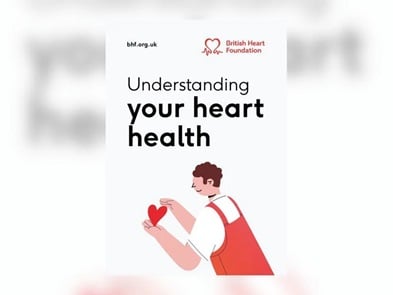
Coronary heart disease
Learn about Coronary heart disease (CHD, also known as Ischaemic Heart Disease or IHD), including causes, symptoms, diagnosis, treatments and prevention.
Coronary angioplasty with stenting (also known as percutaneous coronary intervention or PCI) is a treatment that helps improve the blood supply to your heart. It helps to open up blocked blood vessels when blood is not flowing through as it should.

Angioplasty is a common, generally painless procedure that is used to open up narrowed or blocked arteries (the vessels that supply blood to your heart muscle). You’ll be given local anaesthetic at the start of the procedure. A narrow flexible tube (called a catheter) is put into your wrist or groin (the area of your hip between your stomach and thigh) and pushed up to the coronary artery. A small balloon at the end of the tube is blown up to widen the narrowed part of your artery.
Sometimes if the artery is so narrow that the balloon cannot pass through it, a tiny drill might also be used (this is called rotablation) to chip away at the fatty deposits and gradually widen the narrowing.
Most of the time angioplasty is combined with putting in a small metal mesh tube (called a stent). When the balloon is deflated and the catheter tube and balloon are removed, the stent stays in place, acting like a scaffold to keep your artery open.
You may hear your doctor call coronary angioplasty with stenting a PCI. PCI is a medical abbreviation (name) for percutaneous coronary intervention.

Your coronary arteries play a vital role in keeping your heart healthy. But in some people, fatty deposits can build up and narrow or block the coronary arteries (this is called atherosclerosis, which can cause coronary heart disease). If not enough blood is flowing through the coronary arteries, this can lead to angina or a heart attack.
Coronary angioplasty widens narrowed coronary arteries. This procedure is used:
Angioplasty is not for everyone. Depending on your health and individual heart conditions, you may be advised that you need coronary artery bypass surgery.
In most cases coronary angioplasty and stenting improves the blood flow through the treated artery. Many people find their symptoms get better and they’re able to do more.
Sometimes the artery can become narrowed again (restenosis), causing angina symptoms. But advances in stent technology mean that the risk of this happening is getting lower. Many people are now symptom-free for a long time.
You can improve your chances of long-term success by making healthy lifestyle changes, including:
A small number of people may have coronary angioplasty complications. The risk varies depending on your overall health and your individual heart condition.
The benefits and risks of angioplasty and stenting are different for everyone and depend on the seriousness of your heart disease, your age, and your overall health. The benefits of angioplasty and stenting can include:
Have a chat with your doctor about the benefits and possible risks of having an angioplasty and make sure to mention any concerns you may have.
All types of medical procedures come with risk. With angioplasty and stenting, common complications can include:
The risk of major complications during an angioplasty is usually less than one percent. Rare risks of angioplasty and stenting include:
If you’re worried or have more questions, we encourage you to ask your doctor. They’ll be able to answer any questions specific to you and your procedure. You can also download or order our booklet, Understanding coronary angioplasty.

An angioplasty normally takes between 30 minutes and 2 hours, although it can take longer in some cases. You’ll usually be awake during the procedure but you should not feel any pain.
Your angioplasty and stent procedure will take place in a cath lab – a sterile room in the hospital that looks like an operation room.

If your doctor recommends having an angioplasty and stents, ask them any questions you may have about it. You can then begin to prepare for the procedure, which can help reduce any stress and anxiety you may feel. Preparation may include:
Being as prepared as possible before surgery can help speed up the time it takes to recover. It can also help you feel less worried. Read our 5 top tips on getting in shape before a procedure.
Most people can go home the same day or the next day, but if you’ve had an emergency angioplasty after a heart attack it’s likely you’ll need to stay in hospital for longer.
When you get home, check the area where the catheter tube was put in. Expect to have some bruising and tenderness, but you should contact your doctor if:
you get any pain, redness or swelling.
Before you leave hospital, someone will have a chat with you about your recovery and what you can and cannot do. It’s normal to feel tired afterwards but most people find that they’re back to normal after a few days. However, if you’ve also had a heart attack, it will take longer to recover.
If you’ve had a stent fitted, you’ll be given medicines to help reduce the risk of blood clots forming in and around the stent. They may include:
You may also be asked to take cholesterol-lowering drugs such as statins.
If you’ve had an emergency angioplasty, you may be invited to go on a cardiac rehab programme, a course of exercise and information sessions that help you to recover as quickly as possible.
It can feel worrying to have a stent fitted, especially if you’ve had an emergency angioplasty. But many people find recovering from angioplasty is a positive moment to make healthy lifestyle changes that will improve your health and everyday life.
Before you leave hospital, someone will have a chat with you about your recovery and what you can and cannot do. It’s normal to feel tired afterwards but most people find that they’re back to normal after a few days. However, if you’ve also had a heart attack, it will take longer to recover.
It is possible that you are experiencing discomfort because the stent is taking time to settle. This is quite normal, but you may want to make an appointment to see your GP and check if they want to review your medicines.
A stent will help blood flow in the artery where it has been fitted and will usually improve symptoms of angina. But sometimes other heart arteries can be narrowed too, so you may still have some angina symptoms.
If you get chest pain, stop and rest, and take your GTN if you've been prescribed it. The pain should go away within five minutes. If it does not, take your GTN again.
If the pain has not gone away within five minutes of taking the second dose of GTN, call 999 immediately. You could be having a heart attack.
If you’ve had a planned stent placement, it’s best to avoid doing any demanding activities, such as heavy lifting, for a week or so afterwards.
You may need longer if you’ve had an emergency angioplasty or a heart attack – chat with your doctor to find out what’s right for you.
If you’ve had a planned angioplasty with no complications you may be able to return to work within a few days, depending on the type of work you do.
If you’ve had an emergency angioplasty or a heart attack you may need to take a few weeks off.
You should chat about your own situation with your doctor or nurse.
You should not drive for at least a week after having an angioplasty and stent - longer if you also had a heart attack.
Check with your doctor to see how soon you can drive after having a heart attack and stent. You may need to wait up to 4 weeks.
If you drive a heavy vehicle for a living, such as a lorry or a bus, you must tell the Driver and Vehicle Licensing Agency (DVLA) that you've had a coronary angioplasty. They'll arrange further testing before you can return to work.
It’s not generally recommended to take a long-haul flight soon after having a stent fitted but if you are generally well, and have talked through your situation with your doctor, you may be fit to fly:
Stents are not affected by security systems at airports or MRI scans.
It's normal to feel anxious about having sex if you have a heart condition. But there's no reason why you cannot continue to enjoy a healthy sex life, once you've recovered from having an angioplasty and stent fitted.
In fact, some people who were previously affected by angina, find they are able to have a more active sex life as they have more energy after an angioplasty and stent.
Your doctor will have talked to lots of other people about sex. You will not be the first or the last person to ask. It may not be easy to talk about at first, but most people say they feel a lot better afterwards and are glad they did.
As the day of your angioplasty and stent fitting gets closer, you may feel anxious, afraid, angry, worried about the future, or glad that you’re about to have treatment.
It’s natural to have these feelings and you may continue to have them after the procedure. It’s important to talk about your feelings with your partner, a friend, relative or healthcare professional.
You can also get support by:


We've followed an eight-step process to make sure this content is reliable, accurate and trustworthy.
Learn how we make our health content.


Learn about Coronary heart disease (CHD, also known as Ischaemic Heart Disease or IHD), including causes, symptoms, diagnosis, treatments and prevention.

Angina is a pain symptom felt in your chest, usually caused by coronary heart disease. Learn about the causes, symptoms and treatments for Angina.

Learn about the causes of a heart attack, how a heart attack is diagnosed, treated and how to take care of yourself at home and in the hospital.

